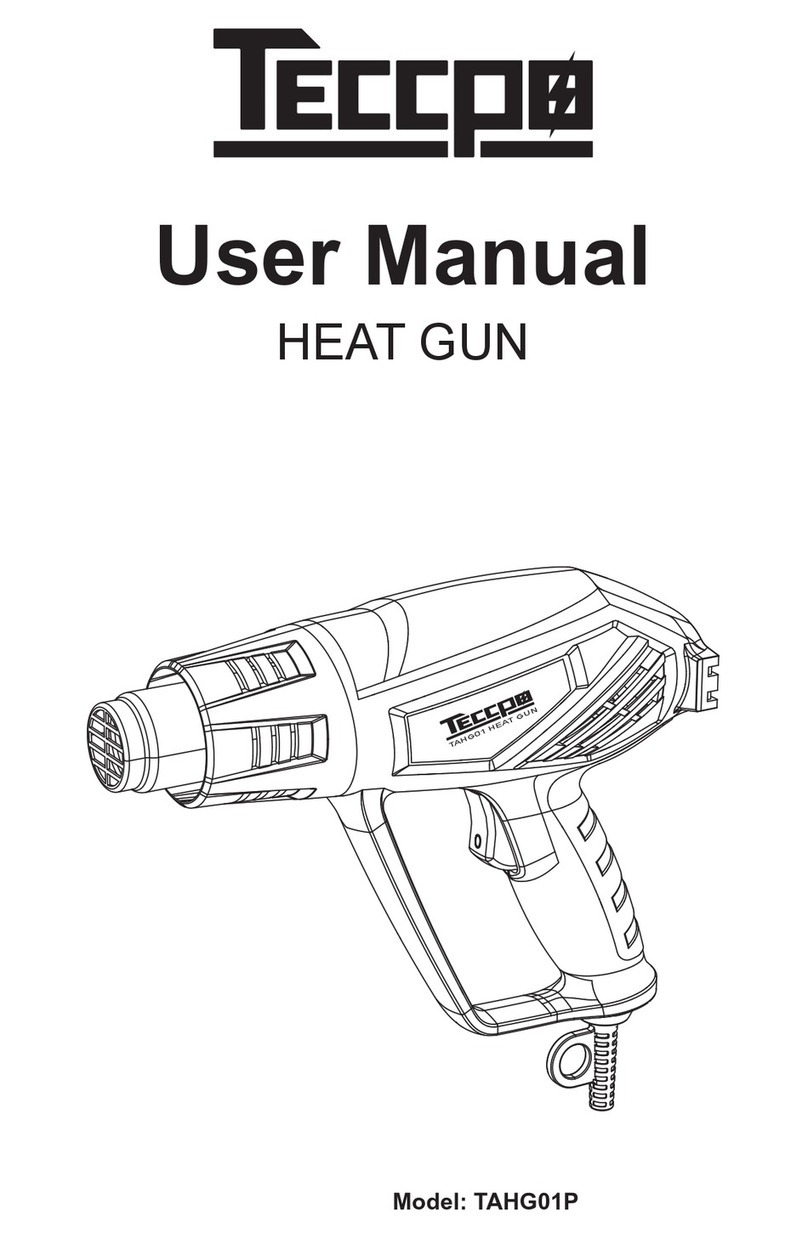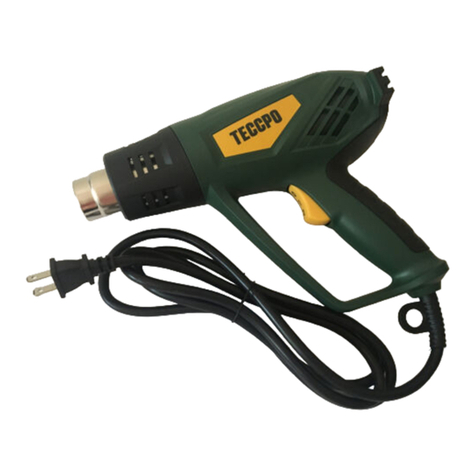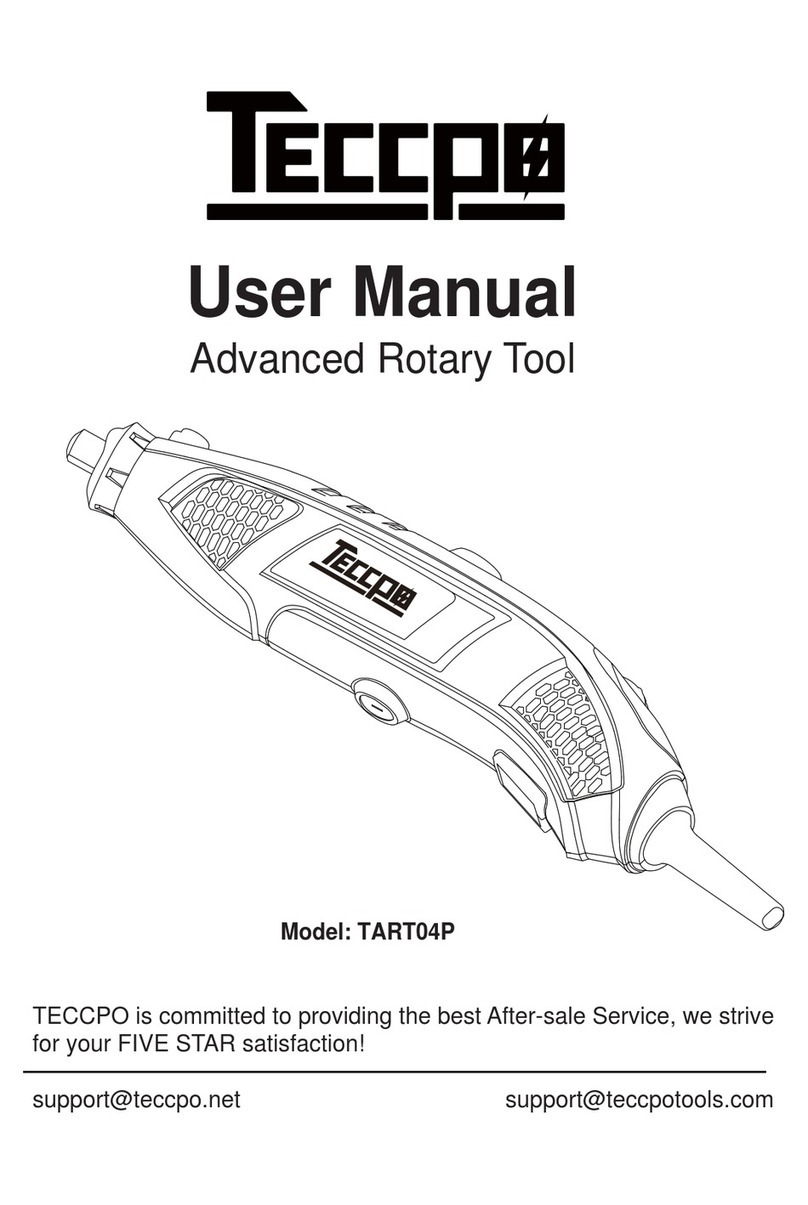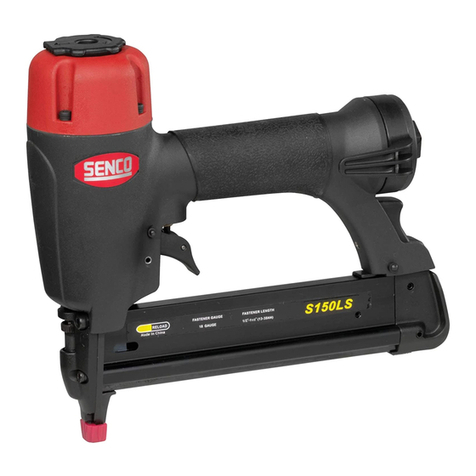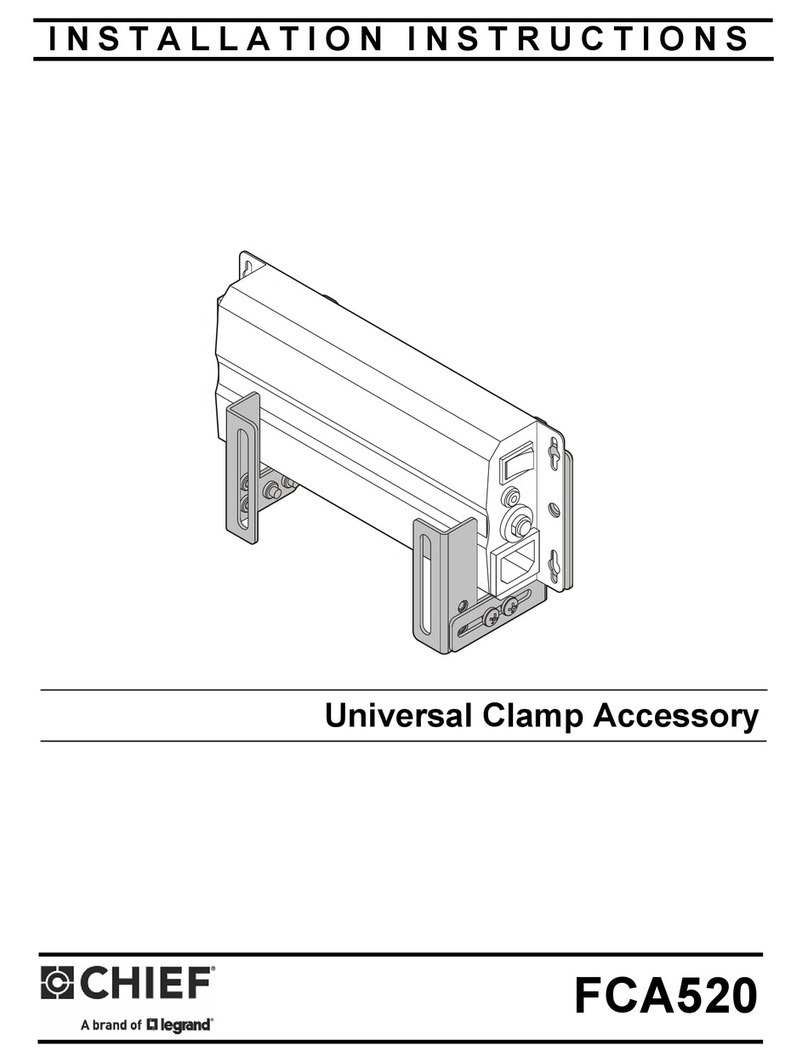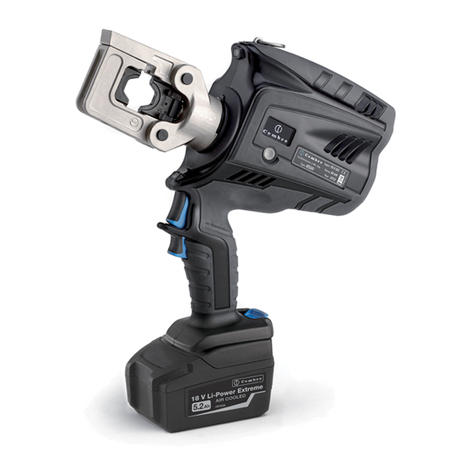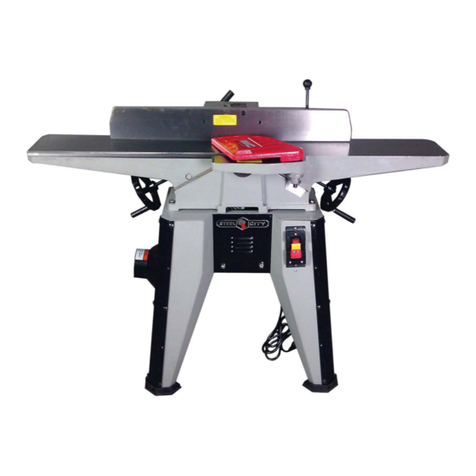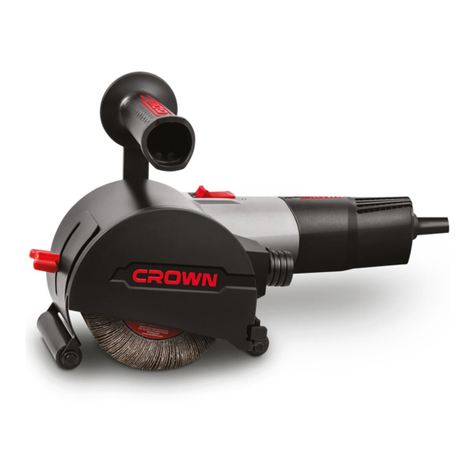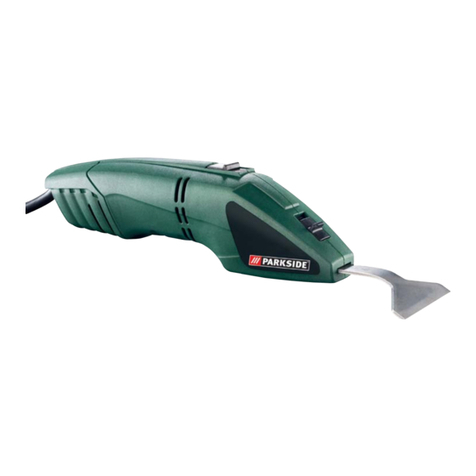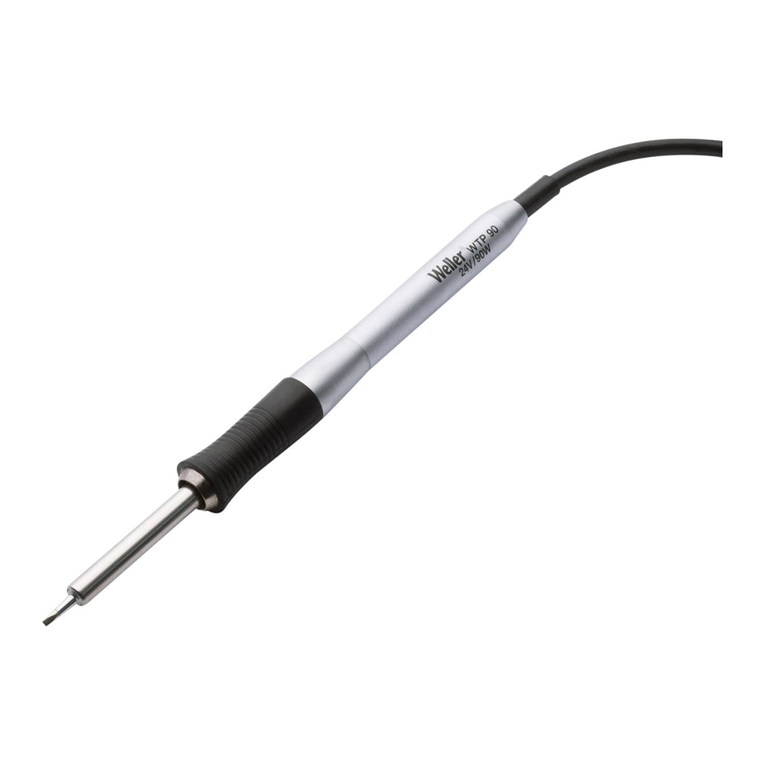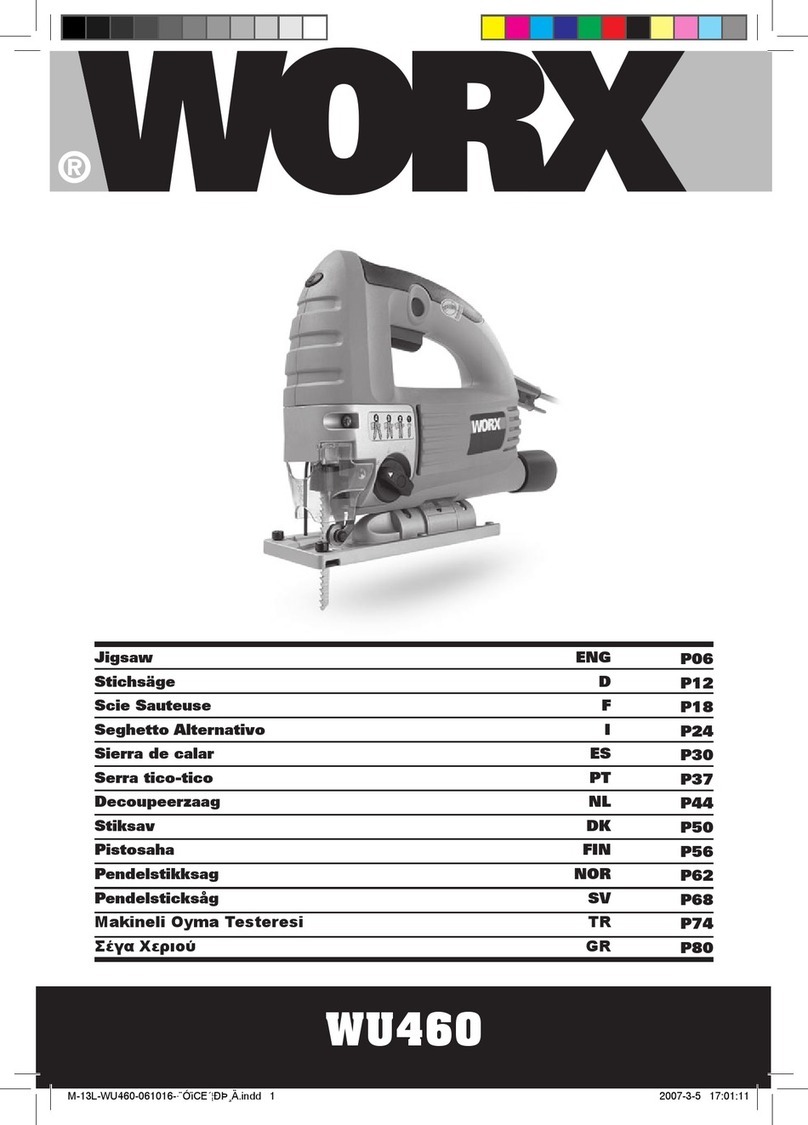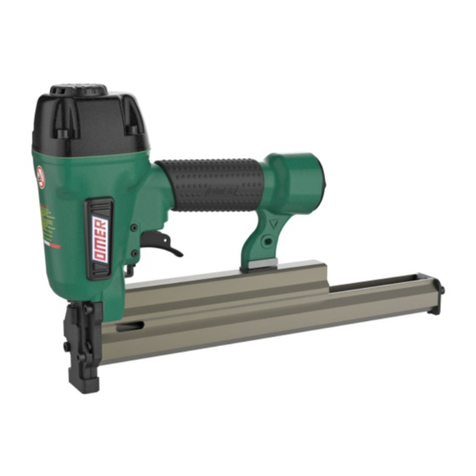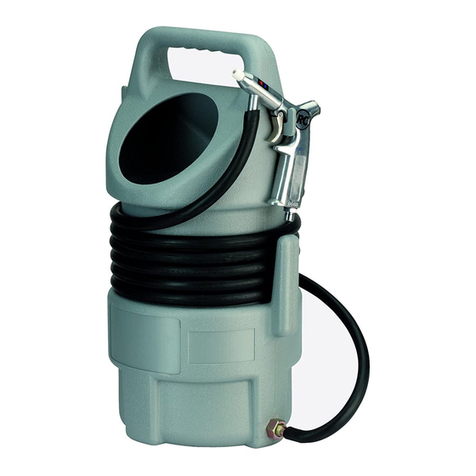Teccpo TDGS01G User manual

User Manual
TECCPO 3.6V USB
Built-in Battery Grass and Shrub shear
Model:TDGS01G


CONTENT
.
.
W y .
-EN-
-01-


-02-
-EN-
1 Grass cutter blade 2 Blade release mechanism
3 Safety lock-off 4 ON button
5 Shrub cutter blade 6 Blade guard
7 USB cable 8 Interlock butten (handle)
8
3
4
2
1
6
5
Fig.1
7
Product description

-03-
-EN-
Fig.2 Fig.3
A
2
c c
B
Fig.4 Fig.5

-EN-
-04-
Pictogram illustration and explanation
1 2 3 4 5 6
7 8 9
1 Warning!
2 After-running of the appliance!
3 Read the operation instructions
4 Do not use tool in wet weather conditions
5 Keep third persons out of the danger zone
6 Attention: Environmental Protection! This device may not be disposed of with
general/household waste. Dispose of only at a designated collection point.
7 Protection class III
8 Guaranted acoustic capacity level LWA 87 dB(A)
9 Rechargeable battery contains lithium! Recycle defective rechargeable batteries!

-EN-
TECCPO 3.6V USB Grass and Shrub shear
Technical Specifications
Battery voltage/operation voltage V DC 3,6
Battery type Ah 1,5
Operating time min. max. 35
No-load Speed n0 rpm 1000
Cutting width * mm 70
Cutting length ** mm 115
Cutting thickness ** mm 8
Weight kg 0,85
Measured Acoustic capacity level dB(A) 87 k=3,0 dB (A)
Noise pressure level as per (DIN EN
60745-2-15) dB (A) 73 k=3,0 dB (A)
Vibrations (DIN EN 60745-2-15) m/s2 <2,5
-The specified vibration emission value was measured by a standardized test methods and can
compare with other power tools are used.
-The specified vibration emission value can also be necessary for the assessment of work breaks
are used.
-The specified vibration emission value can vary during the actual use of the electric tool by spec-
ifying the value,
depending on the way how to use the power tool.
-Note: You create the privilege against vascular pulsations of the hands in time breaks.
-Try to keep the stress due to vibration as low as possible. For example, measures to
reduce vibration stress are wearing gloves when using the tool and limiting the work time.
All phase of the operating cycle must be considered in this regard, (for example, times
when the power tool is switched off, and times when the power tool is switched on but is not run-
ning under load).
-Always keep hands and feet away from the cutting tools, particularly when switching onthe motor!
-05-

-EN-
-06-
Attention: Noise protection! Please observe the local
regulations when operating your device
Intended use
As required, this device may be converted via simple replacement of the included attachments
into grass shears or bush shears.
Hints for your work with the tool
The shrub trimmer cuts ornamental shrubs and light undergrowth or bushes. The device is also
well suited for ornamental cuts as, for example, for the care of graves.
The battery-powered grass and shrub shear can not and should not replace your hedge
shears.
They are exclusively designed to trim and cut back ornamental shrubs and brush wood with a low
wood thickness. Any other use is not deemed appropriate and the manufacturer/ supplier is not
liable for damages resulting from such use.
Please note that our equipment has not been designed for use in commercial, trade or industrial
applications. Our warranty will be voided if the machine is used in commercial, trade or industrial
businesses or for equivalent purposes.
Important! It is prohibited to use the tool to chop material for composting because of the potential
danger to per- sons and property.
The grass shears allow for clean cuts of lawn edges or hardly accessible lawn areas.
Each type of use other than those given in these instructions for use can damage the machine
and cause serious risk to the user.
Please always observe the safety instructions in order to safeguard your guarantee claimand in
the interests of product safety. Due to the machine’s design, we are unable to fully exclude all re-
sidual risks.
Residual dangers
Residual risks always remain even if the hedge trimmer is used properly. The hedge trimmer‘s
design can entail the following hazards:
•Contact can be made with the unprotected blade (resulting in cutting injuries)
•Reaching into or grabbing the hedge trimmer while it is in operation (resulting in cutting injuries)
•Unanticipated, sudden movement of the plant material being cut (resulting in cutting injuries)
•Ejection or catapulting of damaged cutting teeth
•Ejection or catapulting of the plant material being cut
•Hearing damage if the specified hearing protection is not worn
•Inhalation of cut materials

-07-
-EN-
Important!
When using the equipment, a few safety precautions must be observed to avoid injuries and dam-
age. Please read the complete operating instructions and safety regulations with due care. Keep
this manual in a safe place, so that the information is available at all times.
If you give the equipment to any other person, hand over these operating instructions and safety
regulations as well. We cannot accept any liability for damage or accidents which arise due to a
failure to follow these instructions and the safety instructions.
General safety instructions
Attention! Read all instructions contained here- in. Failure to
observe the following instructions may result in electric shock,
burns and/or severe injury. The term ‘power tool’ used in the
following includes both mains-operated tools (with mains supply)
and battery-operated tools (without mains supply).
KEEP THESE INSTRUCTIONS CAREFULLY!
1)Working area
•Keep your working area clean and tidy. Untidy and poorly lit
working areas may lead to accidents.
•Do not operate the tool in potentially explosive environments
containing com- bustible fluids, gases or dusts.Power tools ge-
nerate sparks that may ignite dusts or fumes.
•Keep children and other persons away when you are operating
the power tool. Distractions may result in he operator loosing co-
ntrol over the tool
2)Electrical safety
•The mains plug of the power tool must fit into the mains socket.
The plug must not be modified in any way. Do not use adapter
plugs/ce earthing.
Unmodified plugs and fitting sockets reduce the risk of electric
shock.
•Avoid physical contact with earthed surfaces as pipes,
heaters, ovens and re- frigerators. There is an increased risk of
electric shock if your body earthed.

-EN-
-08-
•Keep the tool out of the rain. The penetration of water into a po-
wer tool increases the risk of electric shock
•Do not use the cable to carry or hang up the tool or to pull the
plug out of the socket. Keep the cable away from heat, oil and
sharp edges or moving parts of the tool. Damaged or tangled ca-
bles in- crease the risk of electric shock.
•When operating a power tool outdoors, use exclusively extensi-
on cables that are approved for outdoor-use. The use of an ex-
tension cable that is suitable for out door use reduces the risk of
electric shock.
3) Personal safety
•Always pay attention to what you do and apply reasonable care
when working with a power tool. Do not use the tool when you
are tired or under the influence of medication, drugs or alcohol.
When working with power tools even a short moment of inatten-
tiveness may result in severe injury.
•Wear personal protection equipment and always wear eye pro-
tection (safety goggles). Wearing personal protection equipment
as a dust mask, nonslip safety shoes, safety helmet or ear pro-
tectors (depending on the type and use of the tool)
reduces the risk of injury.
•Avoid unintentional activation. Ensure that the electrical tool is
switched off be- fore you connect it to the power supply and/or
the battery, pick it up, or carry it. If you have your finger on the
switch while carrying the electrical tool or connect the device to
the power supply with the switch activate, then this may cause
accidents.
•Avoid unintentional operation. Make sure thatthe switch is in
‘OFF’ position before pulling the plug from the mains socket.
When carrying the tool with your finger on the on/off switch or
connecting the tool to the mains supply with the switch in ‘ON’
position, this may result in accidents.
•Remove adjustment tools or wrenches and the like before you
switch the tool on. A wrench or another tool that is inside or on a
turning part of the tool may cause injury.
•Do not overestimate your abilities. Take care of a safe footing
and keep your balance at all times. This will allow you to better
control the tool in unexpected situations.

-EN-
-09-
•Wear suitable clothes. Do not wear wide clothing or jewellery.
Keep your hair, clothes and gloves clear of all moving parts.
Loose clothing, jewellery or long hair may get caught in moving
parts.
•If dust extraction/collection devices are provided make sure that
they are connected and used properly. The use of these devices
reduces hazards caused by dust.
4) Careful handling and use of power tools
•Do not overtax the power tool. Use the power tool intended for
your type of work in each case. The use of the suitable power
tool within the stated range of performance makes working more
effective and safer.
•Do not use a power tool with a dam- aged switch. A power tool
that cannot be switched on or off any more is dangerous and mu-
st be repaired.
•Pull out the plug connector from the socket and/or remove the
battery before you change the device settings, change accessor-
ies, or put away the device. These care instructions prevent the
device from starting unintentionally.
•Store power tools out of the reach of children. Do not allow per-
sons to use the tool if they are not familiar with the tool or these
instructions. Power tools are dangerous if used by inexperienced
persons.
•Thoroughly maintain your power tool. Check whether moving pa-
rts are working properly and are not jamming/sticking, and wheth-
er parts are broken or otherwise damaged in a way that affects
the function of the tool. Have damaged parts repaired before us-
ing the tool. Many accidents are the result of poorly maintained
power tools.
Keep cutting tools sharp and clean. Thoroughly looked after cutt-
ing tools with sharp cutting edges are jammingless often and are
easier to guide.Use power tools, accessories, add-on tools, etc.
in accordance with these in structions and in the way prescribed
for the respective type of tool. You should also consider the work-
ing conditions and the work to be carried out. The useof power
tools for purposes other than those intended for the respective
tool may result in dangerous situations.

-EN-
-10-
5)Appropriate handling and use of battery operated
power tools
•Make sure that the device has been switched off before insert-
ing the battery. Inserting a battery into a switched on power tool
may lead to accidents!
•Only use charging devices recommended by the manufacturer
to charge the batteries. Charging units are usually designed for
certain types of batteries;
if used with other types there is a risk of fire!
•Only use batteries designed for your power tool.
The use of other batteries may lead to injury and risk of fire!
Keep unused batteries clear of paper clips, coins, keys, nails, sc-
ews or other small metal objects that may bridge the contacts. A
short circuit between the battery contacts may lead to burns or fire!
•Improper use may result in fluid leaking out of the battery.
Avoid any contact with battery fluid. Flush with water in case of
contact. If battery fluid should get into your eyes seek medical ad-
vice additionally. Leaking battery fluid may lead to irritations of the
skin or burns!
6)Service
a) Have the power tool serviced by qualified technical personnel
only; repairs should be carried out using exclusively original spa-
re parts. This will ensure the safe operation of the power tool.
Safety instructions for grass- and shrub shear:
•Keep all parts of your body away from the cutting blades.
Do not try to remove cut-off matter with the tool running.
Do not try to hold material to be cut off with your hand. Remove
cut off matter that is stuck between the blades only with the tool
being switched off! When working with hedge trimmers even a
short moment of inattentiveness may result in severe injury.
•Carry the hedge trimmer at the handle with the cutting blades
standing still. Always put on the protection cover when transpor-
ting or storing the hedge trimmer. Careful handling reduces the
risk of injury through the cutting blades.
•Only hold the power tool on the insulated handle surfaces,
because the cutting blade can come into contact with concealed
power lines. If the cutting blade comes into contact with an ene-

-EN-
-11-
rgised line, device parts can become energised and cause an el-
ectric shock.
•Before starting work, search the hedge for concealed objects,
e.g. wire, etc. Pay careful attention to ensure that the cutting tool
does not come into contact with wire or other metal objects.
•Hold the power tool properly, e.g. with both hands on the handl-
es, if two handles are present. Losing control of the device can
result in injuries.
Grass shears safety warning
•This product is not intended for use by persons (including chil-
dren) with reduced physical, sensory or mental capabilities, or la-
ck of experience and knowledge.
•This machine may cause serious injuries. Please read the in-
struction manual carefully as to the correct handling, the prepar-
ations, the maintenance and the proper use of the hedge trimmer.
Familiarize yourself with he machine before the first use and also
have yourself ntroduced to practical use of the machine.
•The cutting tool continues to run after the device is switched off.
•Turn off power before cleaning.
•Beware! Keep your fingers away from the cutting area!
•Only switch on the device if your hands and feet are away from
the cutting tools.
•Remove all debris from the working area before use and pay att-
ention to such debris while working!
•Turn the machine off before transporting and wait until the blade
stops moving. Maintenance and cleaning should be per-formed
only when the machine is turned off.
•Children and teenagers under 16 years of age must never use
this device!
•Never permit children or persons who are not familiar with the
operating instructions to use this device.
•Statutory regulations can restrict the age of the operator.
•Be aware of third persons in the work area.
•Use of the machine must be prevented is people, especially chil-
dren and house pets are present.
•Only use the shear in daylight or sufficiently bright artificial illum-
ination.

-EN-
-12-
•The clippers must be subjected to regular maintenance and che-
cks. Damaged blades must be replaced as a pair. Professional re-
pair is required if damage occurs due to impact.
•The machine should be inspected and maintained regularly by a
responsible re- pair service only.
•Wear suitable working clothes, i.e. protective glasses, protective
means for ears, non-slippery shoes and working gloves.
Do not wear broad clothes which could be caught by the moving
parts.
•After you finish using the clippers and before cleaning them, it is
necessary to ensure that the machine cannot be accidentally turn-
ed on, such as by unlocking the switch.
•Check the cutting unit regularly for damage
•Never hold the clippers by the blades, you may run the risk of inj-
ury even when the clippers are not moving!
•Never touch moving blades in an attempt to remove debris or if
the blades are blocked. Always switch off the device.
•Keep the machine away from children and store it in a safe place.
•When working with the shears, always take a stabile standing po-
sition, particularly when you are using steps or a ladder.
•Do not use shears with a damaged or excessively worn out cutt-
ing part
•Ensure that all protective devices and handles are installed on the
machine. Nev- er try to put an incomplete machine in operation.
•Always use the protective part designed for the blade when trans-
porting and storing the shears.
•Before starting the work, make yourself familiar with the surround-
ings and possible dangers which you may not hear because of the
noise.
•Only use the spare s parts and accessories recommended by the
manufacturer.
•Note that the user shall be responsible himself for accidents and
hazards that result to other people or their property.
•Prior to using the machine, inspect it visually for damaged, miss-
ing, or incorrectly attached protective devices or coverings.
•Never use the machine with damaged coverings or protectivede-
vices or without the covering or protective devices.
•Eye protection, long pants, and sturdy footwear must be worn
the entire time the machine is used.

-EN-
-13-
•The machine should not be used in case of poor weather condi-
tions, especially in case of lightning.
•Always switch off the machine
- if the machine is left unattended.
- before inspecting or working on the machine
- after contact with foreign objects
- if the machine begins to vibrate strangely
Before starting
Items supplied
•Open the packaging and take out the equipment with care.
•Remove the packaging material and any packaging and/or transportation braces (if available).
•Check to see if all items are supplied.
•Inspect the equipment and accessories for transport damage.
•If possible, please keep the packaging until the end of the guarantee period.
Important! The equipment and packaging material are not toys. Do not let children play with
plastic bags, foils or small parts.
There is a danger of swallowing or suffocating !
Charging the battery
Safety Instructions:
-When the hedge shears are delivered, the replaceable battery is not charge. Before starting the
machine for the first time, the battery must be charged
-Use the included charging unit for charging the battery only. It is specially designed to match the
tool’s battery.
-Connect the battery charger only to mains with such a voltage as stated on the type bearing plate.
-Never use other charging unit. This will result in fire and/or explosion hazard!
• Always ensure that the ventilation openings are kept free of for-
eign objects.
• Always maintain your balance to stand securely on slopes. Walk,
don’t run.
• Warning! Do not touch moving dangerous parts before the ma-
chine has been switched off and the moving dangerous parts have
come to a complete standstill.
• A tingling feeling or numbness in the hands is sign of excessive
vibration. Limit the operating time, take sufficiently long work bre-
aks, distribute the work between several people or wear antivibra-
tion gloves when using the tool for extended periods.

-EN-
-14-
-Never try to charge third-party batteries with this charging unit. This will result in fire and/or explo-
sion hazard!
-Check the housing, plug and cable for damage before each use of the charging unit. Do not use
the unit if you detect damage.
-Do not open the charging unit by force. In case of a defect, the charging unit must be replaced.
-The charging unit heats up during the charging process. Do not place the unit on a flammable sur-
face or operate it in a flammable environment. Fire hazard!
-Never open the battery cells. Hazard of short circuits!
-In case of damage to the battery, hazardous vapours or fluids may escape. In case of incidental
contact flush with water and seek medical advice immediately. The fluid may have irritating or cau-
stic effects on the skin.
-Charge the batteries only at a temperature within the range of 10°C to 40°C.
-Store the battery at temperatures up to 30°C only. Higher storage temperatures may result in da-
mage to the battery. The ideal storage temperature range is 10-15°C.
-Protect the battery from heat, intense insolation and fire. Explosion hazard!
-The battery is equipped with a deep-discharge protection feature: the tool is automatically switched
off if the battery is discharged. Recharge the battery immediately if this should be the case.
-Before storing the batteries for the wintertime, charge them fully once more.
Charging the battery pack
•Connect the charger to the charging station (Fig. 2).
•Check that your mains voltage is the same as that marked on the rating plate of the battery charger.
•Plug the battery charger in a socket-outlet. The red LED (Fig. 2 / Item A) comes on to indicate that
charging voltage is available.
•The battery pack is being charged. An empty battery pack requires a maximum charging period of
1.5 hours. The temperature of the battery pack may rise slightly during the charging operation. This
is normal.
•As soon as battery pack is fully charged, the red LED (Fig. 2/Item A) extinguishes. If the recharge-
able battery fails to charge, check whether there is voltage at the socket outlet.
Timely recharging of the battery pack will help it serve you well for a long time.
Recharging is always necessary when you notice a drop in the tool’s performance.
Never allow the battery pack to become fully discharged. This will cause it to develop a defect.
Alternatively the device can also be charged via USB cable on a
computer or something similar.
-Always keep the charging unit clear of rain or moisture. Hazard of electric shock!
- Never charge the battery in the open without protection, always choose a dry, protected place.
Switching the tool on/off (Fig. 1)
Press the safety lock (3) and activate switch (4). After the tool has been switched on,
you do not have to hold the switch-on lock (3) any longer.

-EN-
-15-
Attention! The blades will coast for a certain time after switch-off!
Hints for your work with the tool
As the device is operated with one hand please be careful not to
move the other hand near the running cutting tools.
Cutting grass
The area to be cut must first be cleared of stones and other solid objects.
Allow the grass cutter to glide above the ground. The best results are achieved when the lawn is
dry.
When you notice a drop in cutting performance, re- charge the tool immediately so that the batt-
ery does not become fully discharged.
Trimming hedges
-The tool can be used to trim small hedges and shrubs.
-Hold the tool slightly tilted in relation to the hedge you want to cut.
-First cut the sides from the bottom up, then cut the top.
-Watch out for foreign objects in or on the hedge which could damage the blades.
When is the best time to trim hedges?
-As a general rule, hedges which lose their leaves in the autumn should be trimmed in June and
October.
-Hedges which do not lose their leaves should be cut in April and August.
Changing the blades
Caution! Risk of injury!
To protect against injuries, slide the provided blade guard over the blade and wear protective gl-
oves.
To remove the blade, press the release mechanism (Fig. 3 /Item 2) and move down the blade as
shown in Fig. 3. Once you have removed the blade you will be able to see the toothed wheels of
the gear unit (Fig. 4). Make sure that no dirt gets into the gear unit when you change the blade.
To assemble, proceed in the reverse order. The guide pins (C) must fit into the corresponding re-
ceptacles on the back of the blade.
Adjust the handle angle
-Push inside the interlook button(8) then rotate the ma- chine handle. Fig. 5
-There have 3 position between handle and housing.
-When you chosen the position what you want, then release the rotation button.
To switch off just let go of the switch (4).

-EN-
-16-
Maintenance
Clean the blade from any crushed plants and dirt. The blades should be detached at least once
a season for the removal of debris.
Warning! The leading edges of the blades must be oiled to ensure proper lubrication.
If the leading edges are not oiled, blade durability may be adversely affected.
If the cutting tools have become dull after long use please replace them with original spare parts.
Clean the device using only a brush or cloth. Do never wash down the device with water and do
never dip the device into water.
Apply protective spray to the blades after each use. Replace blunt blades.
Always put on the blade guard after use.
Examine the tool for obvious defects and have it re- paired in an authorised service shop if requ-
ired.
Storage
Always store the tool in a dry, clean place outside the reach of children. Make sure that the place
of storage is frost-free.
Waste disposal and environmental protection
Please observe the following directions for the disposal of your accumulator/battery.
Batteries are not to be put into the rubbish. As a consumer you are legally obliged to
return used batteries and accumulators.
At the end of the duration of your apparatus, the batteries or accumulators have to
be taken from the apparatus, disposing of them separately.
You have the possibility of delivering your old batteries and accumulators to the local
collecting points of your municipality or to your dealer or to the distribution centers.
If your device should become useless somewhere in the future or you do not need it anylonger, do
not dispose of the device together with your domestic refuse, but dispose of it in an environmentally
friendly manner.
Please dispose of the device itself at an according collecting/recycling point. By doing so, plastic
and metal parts can be separated and recycled. Information concerning the disposal of materials
and devices are available from your local administration

-EN-
-17-
Spare parts
If you need accessories or spare parts, please contact our Service department.
When working with this tool, do not use any accessory parts other than those recommended by
our company. Otherwise the operator or others in the vicinity could suffer serious injuries, or the
tool could be damaged.
The following information should be provided when ordering spare parts:
•Type of machine
•Item number of the machine
Warranty
For this tool, the company provides the end user - independently from the retailer‘s obligations
resulting from the purchasing contract with the following warranties: The warranty period is 24
months beginning from the hand-over of the device which has to beproved by the original pur-
chasing document. For commercial use and use for rent, thewarranty period is reduced to 12
months. Wearing parts, rechargeable batteries and defects caused by the use of non fitting ac-
cessories, repair with parts that are not original parts of the manufacturer, use of force, strokes
and breaking as well as mischievous overloading of the motor are excluded from this warranty.
Warranty replacement does only include defective parts, not complete devices. Warranty repair
shall exclusively be carried out by authorized service partners or by the company‘s customer
service. Inthe case of any intervention of not authorized personnel, the warranty will be held void.
Table of contents
Other Teccpo Power Tools manuals

